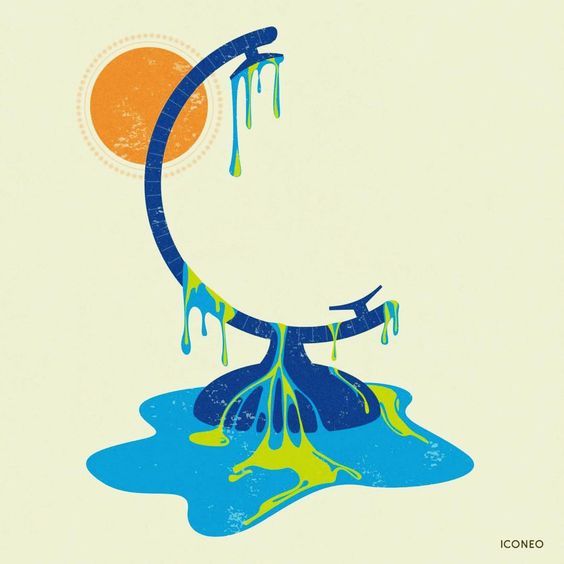Drip, drip, drought... How can fashion brands reduce water waste during production?
Water is life. It is one of the first elements scientists look for when exploring space for intelligence. All the earliest, most powerful civilizations settled and flourished by flowing bodies of water. Life as we know it ceases to exist without access to healthy water ecosystems.
Today, water resources are under pressure and it threatens the well-being of the entire planet and humanity. We are seeing first-hand the power of water and what happens when it is mismanaged. From entire countries flooding with no apparent warning to others living on the edge of an eternal drought, the question on society’s mind remains: What can we do before it’s too late?
The Pretty Ugly Truth
Water usage - as well as its waste - within the fashion industry has been an ongoing issue - it's the not-so-pretty side of fashion that most big fashion houses refuse to ethically and sincerely address.
However, the numbers don’t lie: research shows that in order to process an amount as small as one kilogram (2.2 pounds) of any kind of fiber, the fashion industry requires a minimum of 100 to 150 liters of water. Roughly, these numbers represent water that may end the thirst of around 100 million people.
Is it too late to make a difference?
While some brands have taken a few steps forward towards this issue: implementing more environmentally friendly materials, opening new paths for more sustainable production chains, and using the words “conscious” and “waterless” on their labels, we still need more impactful action to save our precious waterways And we, as designers and creators, can always ask ourselves how we can do better when producing garments.
There’s no doubt that no brand will ever be perfect, or 100% water free. However, we have gathered a few easy steps that can definitely help guide you through the process of choosing which brands can walk alongside you during your eco-conscious journey into building a better, waterful, planet.
Time to go organic!
Even though organic cotton is far from perfect when it comes to its impact on water waste and sustainability, it surely can be a way better option. According to recent data, producing a plain and simple “regular cotton” shirt can require as much as 2500 liters of water. However, by using organic cotton instead, brands will be able to reduce water waste to up to 91%, creating a huge positive impact on our planet, one shirt at a time.
Same old cotton, a brand new life!
As previously mentioned, cotton requires a large amount of water during its production.. The easiest and best solution for this ongoing issue, other than reducing production levels themselves, is to opt for recycled fabrics instead. This way, brands, and creators will still be able to get the same quality of product, in a much more sustainable manner, contributing to a safer, greener, and drought free planet.
Transparency in the supply chain
All fabric producers source their textiles in different ways, some more conscious than others. Luckily, most of the time, designers, manufacturers, and creators are given the opportunity to decide from where they'd like to source their materials. By partnering with sustainably certified - and often smaller - producers, these same designers, manufacturers, and creators can make a huge difference when it comes to influencing fashion’s water waste footprint.
As a customer, you can look for brands that are transparent about their supply chain and where they source their materials from, and which factories they work with.
A piece of waste now, a Masterpiece later!
Producing a single garment involves a lot more fabric than what ends up in your hands as the final product. Countless are the clipped snippets and perfectly good pieces left behind, going to waste and polluting our planet. Not to mention, all those tiny pieces were once produced by using our precious - and scarce - water resources. So the question is, why throw them away? By saving and reusing leftover materials, not only are we able to create unique garments and designs, but we are also decreasing the use of water in the fashion industry and reducing the waste of crucial materials. See, for example, our midi dresses are made from extra material that would otherwise have gone to waste.
Color(ful) Responsibility
Fabric dyes bring joy to any collection, allowing designers to express their creativity in endless ways. The number of hues derived from one single color can be unlimited, but so is the level of water pollution this exploration of synthetic dyes causes.
Multiple dyes are notorious for infiltrating water supply, making it impossible to purify. However, by choosing more natural and alternative dyes (much like the ones used in the woodprint art of Ajrak), companies will be able to reduce this impact and even allow some of this water to be reused and recycled for this process.
A quick goodbye to fast fashion!
Even though our last suggestion should come as a no-brainer, it’s always worth mentioning. Please, say goodbye to fast fashion, and low-quality brands. Invest in truly eco-conscious, long-lasting, and wonderfully crafted pieces that will last you a lifetime. Not only are you purchasing something you can pass on to future generations, but you are also allowing those same generations to have a place they will be able to call home.
And as you make these choices, share them with your friends, family, loved ones. We have the most influence with the people closest to us and we can use that influence and our own life choices to gently and compassionately introduce others to different way of being that is better for us and the planet.


